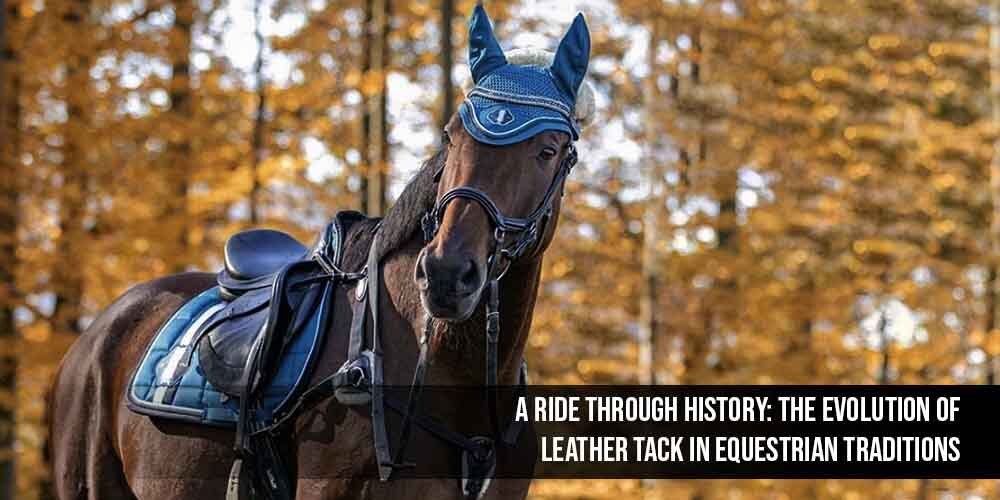Table of Contents:
Equestrian Traditions: A 1500-Year Journey through Leather Tack
Equestrian traditions have deep roots that extend through centuries and across continents. At the heart of these traditions lies the enduring significance of leather tack, a material that has played a central role in the world of horse riding for generations. In this article, we embark on a journey through history, tracing the development of leather tack in equestrian traditions and highlighting its lasting impact.
Ancient Beginnings: The Birth of Leather Tack
The use of leather tack can be traced back to the earliest civilizations where horses were revered for their role in transportation, agriculture, and even warfare. In these ancient times, early forms of leather tack were rudimentary, consisting of simple harnesses and saddles crafted from basic materials. As the importance of horse riding grew, riders recognized the need for control and comfort, which led to the gradual refinement of leather tack.
Medieval Europe: The Rise of Chivalry and Leather Tack
One of the significant milestones in the evolution of leather tack occurred during the medieval period in Europe. The age of chivalry brought with it an emphasis on jousting, tournaments, and equestrian warfare. Leather saddles, bridles, and other tack became more specialised, designed to provide both stability and protection for the knight in battle. The importance of well-crafted leather tack became apparent as it contributed to the rider's control and safety during combat.
The jousting tournaments of the Middle Ages showcased the elegance and strength of leather saddles. These saddles were not just functional; they were intricately designed, featuring ornate tooling and decorations that symbolised the status and identity of the rider. These tournaments were not only about combat but also a display of craftsmanship, with each saddle being a work of art in itself.
Colonial America: Leather Tack and Pioneering Spirit
In the New World, particularly during the colonial era of America, leather tack took on new importance. Early settlers and pioneers depended on horses for exploration, transportation, and agriculture. Leather tack was essential for settlers who ventured westward on horseback, as they encountered challenging terrains and had to cross vast distances. Leather saddles, bridles, and reins played a pivotal role in their ability to traverse the American frontier. It was leather tack that enabled them to pioneer new paths and lay the foundation for the expansion of the United States.
The 19th Century: Riding in Style and Function
The 19th century witnessed a transformation in equestrian traditions. The emergence of leisure riding and the rise of horse shows and events introduced a new emphasis on style and elegance in horse tack. Leather tack, with its timeless charm and versatility, adapted to complement the changing tastes of riders. Elaborate saddles and bridles with intricate tooling and embellishments became fashionable, blending functionality with aesthetics.
During this period, the elegant look of leather tack not only served functional purposes but also made a statement about the rider's status and identity. It reflected the rider's appreciation for the rich heritage of equestrian traditions while embracing the evolving aesthetics of the era.
Modern Times: Tradition Meets Innovation
In the modern era, equestrian traditions have evolved, with new sports, disciplines, and technologies shaping the world of horse riding. However, while some elements have changed, the essence of leather tack remains unaltered. Leather saddles, bridles, reins, and other equestrian gear continue to be crafted with precision and care. Modern technology and innovations have allowed for enhanced durability, comfort, and performance in leather tack.
The enduring significance of leather tack lies in its unique combination of tradition and adaptability. It pays homage to the rich history of equestrian traditions while embracing contemporary advancements. Riders today still experience the connection between horse and rider that has remained a constant throughout history, thanks in part to the reliability and comfort provided by leather tack.
Conclusion: A Legacy of Excellence
The evolution of leather tack in equestrian traditions reflects the enduring significance of a material that has been a constant companion to riders throughout history. It has adapted to the changing needs of various eras while maintaining its fundamental role in horse riding. The legacy of leather tack is a testament to the enduring bond between humans and horses, a connection that transcends time and continues to shape the world of equestrian traditions.
As riders saddle up for each new journey, we do so with the weight of history and tradition, carried by the timeless beauty and functionality of leather tack. It's a reminder that while the world may change, the essence of the rider's connection with their horse and the role of leather tack in equestrian traditions remain steadfast and unchanging. The journey through history continues, guided by the enduring legacy of leather tack.
FAQs:
Leather tack refers to the equipment used for horse riding, including saddles, bridles, reins, and harnesses, traditionally crafted from leather.
Leather tack has evolved to meet changing rider needs, from basic harnesses to intricate and functional gear, blending style and function.
Leather tack in the Middle Ages was crucial for knights, offering stability and protection during jousting, tournaments, and equestrian warfare.
Leather tack was essential for settlers and pioneers, enabling them to explore, travel, and pioneer new paths in the New World.
Leather tack continues to pay homage to tradition while embracing modern technology and innovation for enhanced durability and comfort.
"Ashva" means horse, symbolising the power and passion of riding, which our company aims to reflect in our premium leather goods.
Ashva's three generations of experience, commitment to sustainability, and premium quality products make it a top choice for horse owners.
We prioritise offering the best products at honest prices, maintaining uncompromising quality, responsible leather production, and environmental care.
Our skilled team combines tradition and innovation to create flexible and athletic leather products that prioritise both rider and horse comfort.
Our specialised customer service team collaborates with our equine merchandising and purchasing team to provide up-to-date product information and support customer inquiries.




